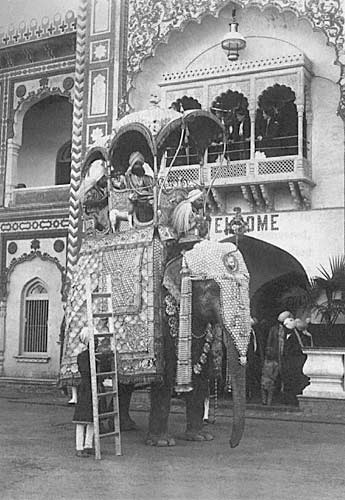As a photographer in his brother-in-law’s studio in Lucknow, Bremner went to work with army cantonments spread across northern India, from Allahabad to Karachi. Military men came to him to be photographed and to buy postcards made from his photographs.
His income for several years came mainly from army photographs, even after he established himself independently. But by 1902, he moved on to other projects, including the Delhi Durbar. The Delhi Durbar, a mass assembly to mark the succession of the emperor or empress of India, took place thrice under British rule: 1877, 1903 and 1911. He travelled a fair deal and was commissioned to create portraits of viceroys, maharajahs, nawabs and even the Prince of Wales.
In 1923, Bremner sold his established studio in Shimla and returned to the UK. Seventeen years later, he published a memoir, My Forty Years in India.
Bremner was a talented practitioner of photography, but he also had an unusually well-developed sense of the meaning and potential of the form, at a time when people were not very concerned with its theoretical aspects.
“Artists – painters, I mean – tell us that photography is not a fine art,” he wrote in Forty Years. “Cut out the word 'fine' and art remains. Certainly mechanical means have to be used up to a point, and many amateurs believe that when equipped with a nice camera and lens nothing else is necessary. The 'button' does the rest. Believe me it is the man or the woman behind the instrument that matters.”
Curators at Harappa.com have presented some images from this book on their website. Here are some.

"The journey through the Bolan Pass is barren, devoid of any trees or even a blade of grass, only steep mountains on either side, and yet there are to be seen flocks of sheep – grazing on what! One wonders until they are told that the soil contains a herb which the sheep find and by their appearance it is evident they fatten on the product. I never saw such healthy looking animals anywhere and covered with great masses of woolly coats. The mutton in Baluchistan is famed for its fine quality. Honestly I have never tasted better anywhere, not even in Scotland."
(Forty Years, pages 30, 31)

"Sir James Brown [the British Governor] met the Khan in a hall where the public were admitted. I happened to be one of the audience. When Sir James appeared on the platform the Khan made a rush forward to greet him. He was immediately repulsed by the Governor, who shouted, 'Stand back, you murderer,' and reviled him in severe language on the tragedy he was guilty of [the execution of his Prime Minister and son]. The Khan was afterwards consigned to a Fort for safe keeping. He died a few years later."
(Forty Years, page 34)

"Passing through the Jhelum Valley and river the steep mountain sides are clad with pine, deodar and other trees of stalwart height, and in the depths of the valley below, some 3,000 feet, the river winds its tortuous way, just as the road winds through the mountains as far as the river below and rising again to the summit of a few thousand feet – their eye may sometimes rest on a figure slowly gliding through mid-air with no apparent support whatever. Coming to close quarters one sees a crossing by rope bridges. It is a curious way of engineering these people have. One of the bridges is merely a single rope made of tough twisted cowhide and secured at both banks of the river. The passenger is seated in a small suspended cradle. He then lets himself go and his own impetus carries him fully half-way over and he is pulled across the remaining distance by a smaller guiding rope."
(Forty Years, page 45)

"Leaving the city one cannot do better than be rowed up to the Dhal Lake, which is aid to be one of the most beautiful spots in Kashmir... Entering the Dhal Lake, which measures about 4 miles by 2 1/2, one cannot help but admire the works of nature which are depicted in a variety of beautiful ways in the stillnes of the water combined with mirror-like reflections of the mountain ridges."
(Forty Years, pages 48, 49)

"The stillness and clearness of Dhal Lake make it comparatively easy to catch fish with the aid of a spear instead of by rod and line. Boatmen are the class with whom visitors to Kashmir come most intimately in contact. They are said to claim Noah as their ancestor, and certain it is that if they did not borrow the pattern of their boats from Noah's Ark, Noah must have borrowed the pattern from them! Families live permanently on the boats, and they all have their little cooking places on board, and an enormous wooden pestle and mortar with which women and very often children pound the rice or grain."
(Forty Years, page 48)

"My first introduction to a Rajah in the Punjab was, in a measure, due to the Delhi Durbar [1902]. The Maharajah of Jind dropped into my studio to enquire about Durbar photographs. I had on view an enlargement ‒ in which Lord and Lady Curzon figured in a procession on arrival at Delhi. His Highness took the framed picture away, and from that time I had the pleasure of being called to his State, especially once a year, to photograph his daughter the Princess on the occasion of her birthday."
(Forty Years, page 65)
Images published with the permission of Harappa.com, which describes itself as a "media spigot to South Asia's past". This article is based on an essay by Brij Bhushan Sharma.










